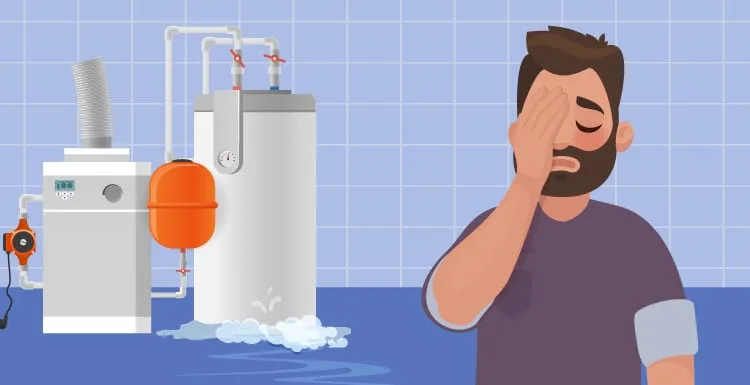Are you coming up short in your search for “water heater leaking from bottom” fixes?
If so, good thing you found our guide. We’ll cover everything you need to know. Read on to learn more.
Water Heater Leaking From Bottom?
Discovering your water heater leaking from the bottom might make you think it’s time to replace the entire water heater.
Fortunately, a water heater leaking from the bottom could indicate a problem that has a relatively simple fix.
In some cases, you may need to replace the entire water heater. But it’s important to troubleshoot first to avoid replacing a water heater that could be otherwise repaired.
In this guide, we’ll explain how to troubleshoot this problem and see what’s causing the leak, talk about how to fix each problem, and recommend when to call a plumber.
Water Heater Leaking From Top
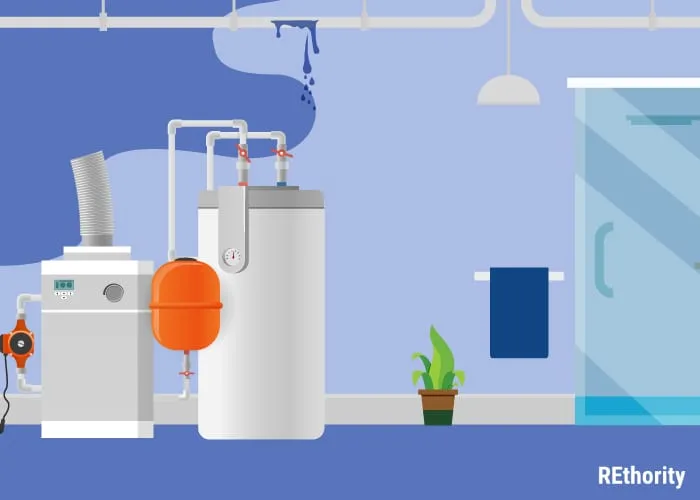
Before you begin troubleshooting potential causes for a leak from the bottom, make sure that’s the source of the leak. If your water heater leaks the top, you could be in luck.
The water may run down through the water heater and find an exit point at the bottom, making it look like a bottom leak.
Check the top of the water heater thoroughly for any sign of a leak. Look over the pipes that lead to and from the water heater. If you’re still not sure, you can turn off the power and take off the access panel.
Look inside for any moisture in the insulation, which would indicate a leak higher up that is traveling down the heater. If that’s the case, it could be a relatively easy fix.
If you do notice that the leak seems to be originating from the top, you should call a plumber. They can determine what the source of the leak is and install the correct replacement parts.
Water Heater Leaking From Bottom
Once you notice a leak from the bottom of your water heater, there are two important parts to check first: The temperature and pressure relief discharge pipe and the drain valve.
1. Pressure Relief Valve
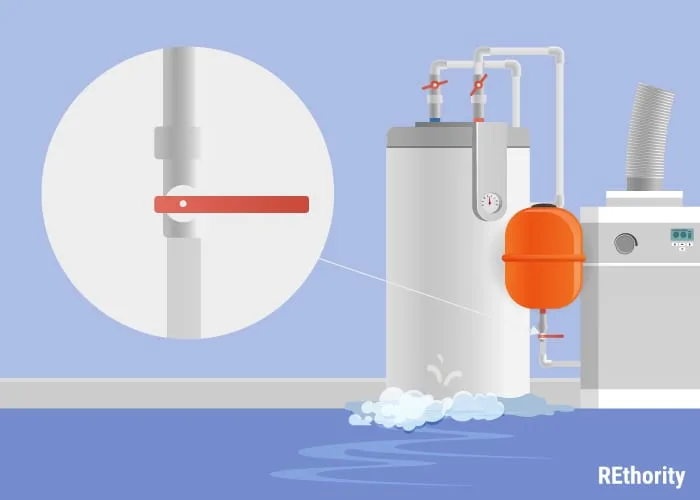
The temperature and pressure relief discharge pipe runs down your water heater and stops about 6 inches above the floor. The temperature and pressure relief valve at the top of your water heater opens.
Why?
Becuase it helps release or discharge water into this pipe when the pressure levels inside the water heater rise to dangerous levels. After all, it gets hot inside the water heater, and water expands when heated.
Hot Water Expands
This is usually when the water inside the unit gets above 210 degrees or when the pressure inside builds to above 150 psi. The valve opens to let water out of the discharge pipe to quickly reduce the amount of pressure.
Using this system, excess pressure is released, which avoids an explosion or tank damage. When this happens, you might hear a hissing sound as the pressure relief valve opens and releases water into the discharge pipe.
If the temperature and pressure relief discharge pipe is causing your water heater to leak from the bottom, you will notice water dripping from this long pipe.
This indicates that the pressure inside your water heater is too high and causes your temperature and pressure relief valve to open.
2. Check the Thermostat Temperature Setting
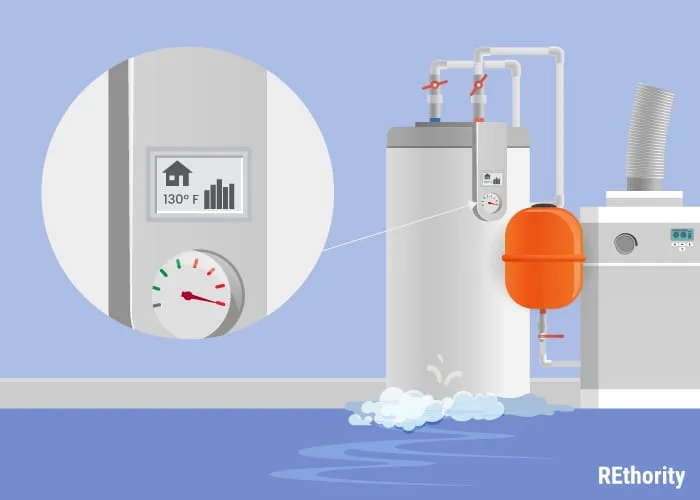
One quick fix you can try on your own is a quick check of your thermostat’s temperature setting.
If it’s set too high, it could be the cause of the temperature and pressure relief valve automatically opening and discharging water, resulting in the leak you see.
Many water heaters do not have a temperature gauge that allows you to read the temperature setting directly. So you will need to do a little experiment to find to which temperature yours is set.
You will need a heat-safe cup and a cooking thermometer. Don’t use your water heater for one hour, then turn on the faucet located closest to your water heater.
Then Try These Fixes
Let it run for one minute to let it reach its full temperature and fill the cup. Now, place the cooking thermometer into the water and read the temperature.
- The OSHA recommended temperature is 140 degrees Fahrenheit (usually, this is the factory setting for water heaters).
- The Consumer Product Safety Comission recommends setting your water heater thermostat to 120 degrees Fahrenheit to reduce energy usage, but a booster heater might be needed to allow water to get hot enough to sanitize in dishwashers and washing machines.
- Set your thermostat to 130 degrees Fahrenheit to get the best of both worlds: Hot enough to sanitize, but cool enough to prevent scalding or unnecessary energy usage.
If you adjust the thermostat to reduce the temperature and still see a leak, it’s time to call a plumber and explain the problem.
They’ll inspect your water heater thoroughly and safely to find out what’s causing the pressure to rise inside the water heater.
3. Drain Valve
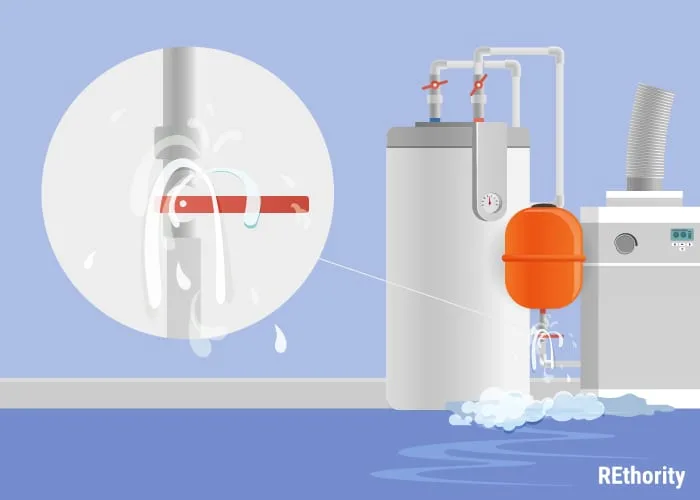
The drain valve on your water heater looks like a small spigot at the bottom of the tank. It gives you access to the water heater tank and enables you to drain, clean, and refill it as part of routine maintenance.
If you see water dripping from the drain valve or the drain opening, it’s a sign that the valve itself cannot close properly and is slowly leaking water from the tank.
A worn washer inside the drain valve is a common reason to see leaks here. The drain valve will need to be taken apart to check the washer and see if it needs to be replaced.
When in Doubt, Call a Pro
Calling a plumber is the best course of action for this, as over- or under-tightening parts around the drain valve can result in a worse leak or even flooding.
If you live in an area with hard water, it could be mineral buildup (calcium, preventing the drain valve from closing all the way and resulting in the leak you see.
There’s also the possibility of particles and sediment in the water building up over the years and preventing proper valve closure. You can try tightening the drain valve to see if it stops the leak.
If you see water leaking from the drain valve, you’ll know it’s time to call a plumber in for a full inspection. They will take the water heater drain valve apart, drain the tank, and determine if that is the problem’s extent.
4. Condensation
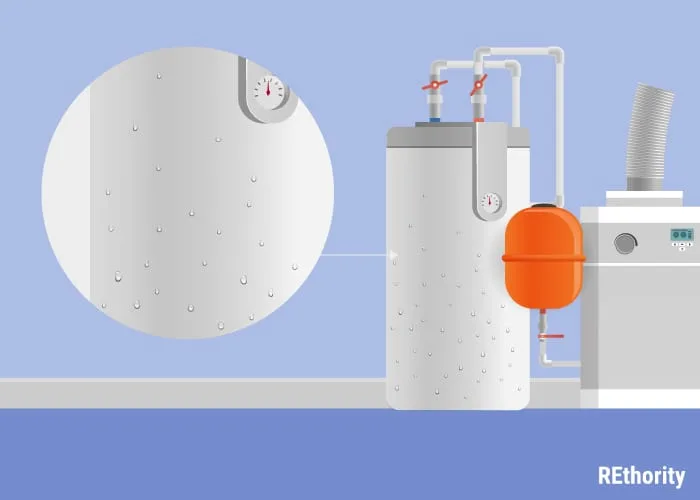
If you’re noticing water around the water heater (either dripping or somewhere on the tank), condensation could be the source. Older water heaters more commonly have this issue because of poor insulation.
Side note — did you know that insulating your water heater can reduce your water heating costs by up to 16%?
With insulation blankets available for around $20, there’s no reason not to!
Thermostat Set Too High
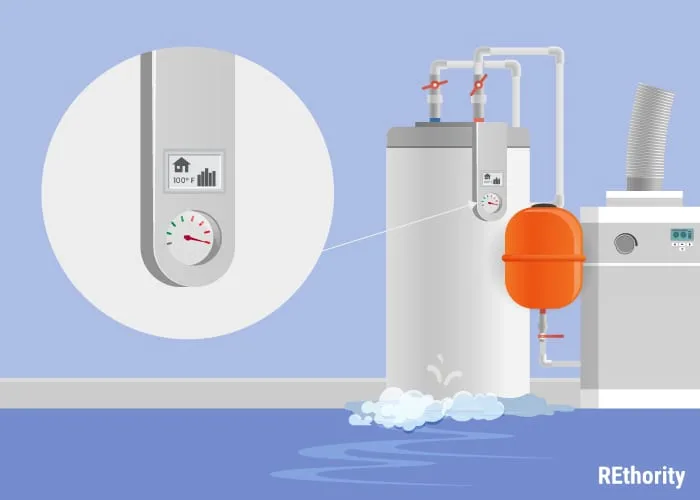
However, newer tanks can have condensation if there’s a problem with the insulation or thermostat setting. You might notice condensation on the outside of the tank if you’ve just had a water heater installed.
This is because the cold water filling the water heater tank is not yet heated, causing a difference in temperature between the inside and outside and resulting in condensation.
Perform a Quick Test
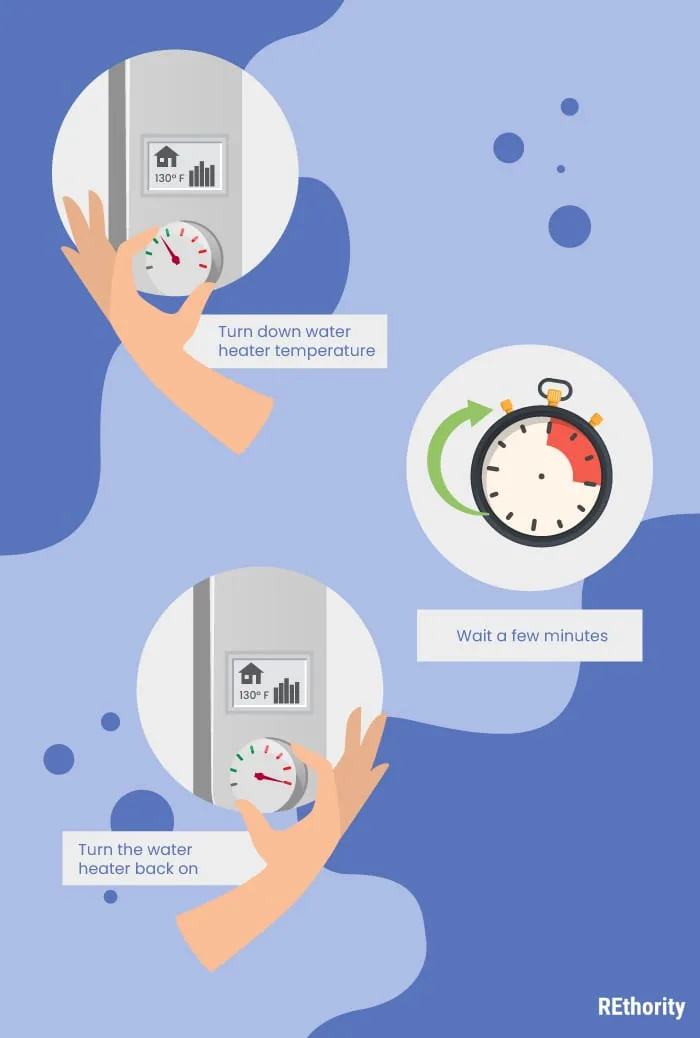
To determine if condensation is the source of leaking from the bottom of the tank, you can do a quick test. First, turn off the electric power or gas to the tank. Let it sit without being used for a few hours.
Come back and check the water heater to look for any sign of a leak or additional condensation. If you don’t see anything, this makes it very probable that your leak was really condensation.
Reduce Temperature
You might consider turning down the water heater’s thermostat to reduce the temperature and see if that fixes the problem long-term.
If the test didn’t stop the leak, or if it returns shortly after turning the water heater back on, you will need to call a plumber.
There may be an issue they can point out that will easily fix the problem or a leak in a different area. They may also recommend that you buy an insulated water heater to prevent condensation problems in the future.
5. Rusted Bottom
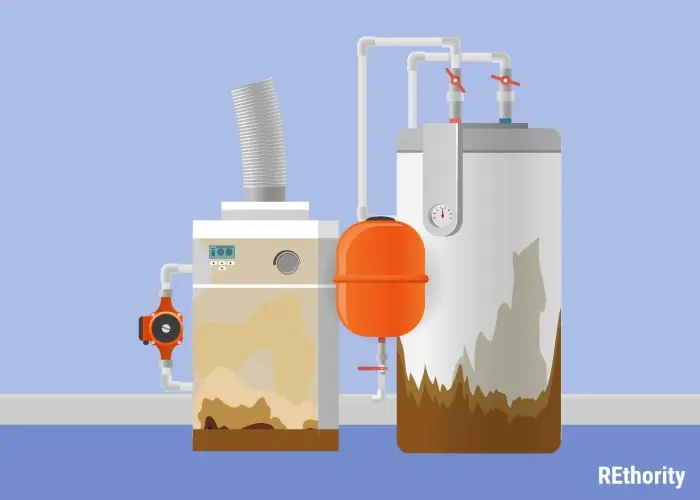
The presence of water in your water heater tank takes its toll over the years. Salt, other minerals, and chemicals in your water slowly corrode and rust the inside of your water heater tank.
First, small, pinhole leaks will form from corrosion. The intense pressure inside the tank forces those pinhole leaks to grow bigger and bigger over time, increasing the water lost through leaking.
Eventually, the tank’s leak can get bad enough to flood the area. Often times, these leaks are pressurized, meaning they will spray all over the room.
Water Heaters Rust Over Time
Water heaters have to be replaced every 10 to 15 years due to normal wear and tear on the appliance.
If you see water leaking from the bottom of the tank inside the burner compartment, it might indicate that the bottom is rusted through.
If you’ve had your water heater for a decade or more, normal sediment buildup can accelerate rust and cause the bottom of the tank to erode. The water from the tank then leaks through and becomes noticeable.
If the bottom of the tank is rusted through, that’s your indication that a full replacement is needed. There’s no safe way to repair a corroded or rusted tank.
When to Call a Pro
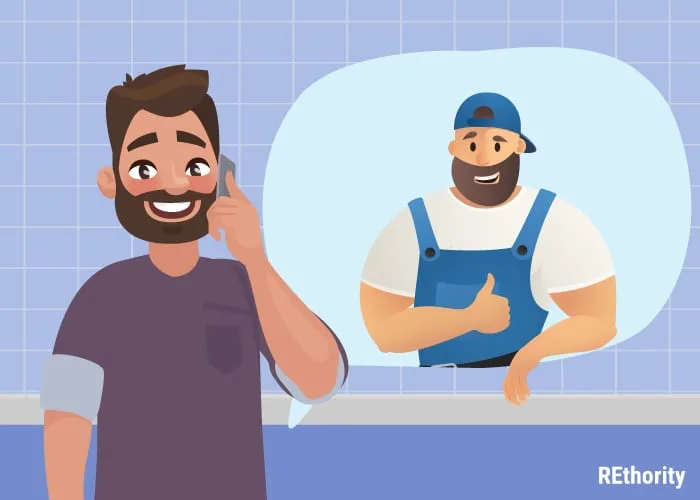
There are a few cases where you can troubleshoot and fix what’s causing your water heater to leak from the bottom. We’ve outlined these above.
A simple adjustment of your thermostat temperature setting or a drain valve that just needed tightening are possible DIY fixes for a leaking water heater.
If you can’t pinpoint the source of the problem causing your water heater to leak from the bottom, calling a plumber should be your top priority.
We partnered with Networx to help you find local plumbers in your area. Click to below to get a FREE quote.
Water Heater Leaking From Bottom?
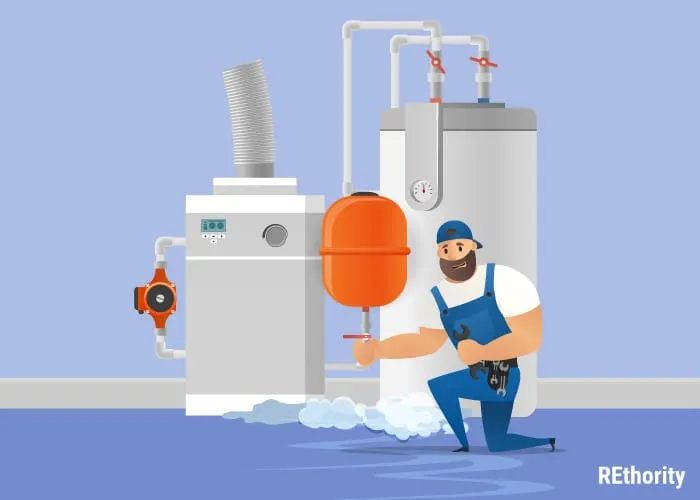
Still trying to fix a “water heater leaking from bottom?”
It’s time to call a plumber. A pro will inspect your water heater and its parts to determine where your leak is coming from.
In some cases, they can repair or replace a part or tighten or adjust a component to stop the leak.
In other cases, like a rusted bottom or poorly insulated water heater, they will recommend the replacement of the entire water heater.

